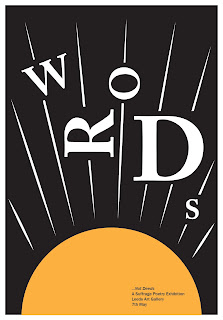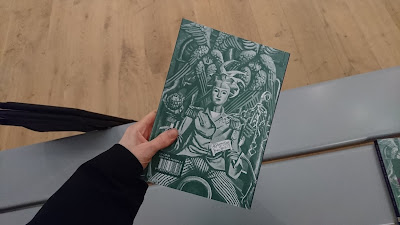Often the poems written
by suffragists about their experiences, are only discussed as 'visual
artefacts' and nothing more to the movement. Links between the fight
for enfranchisement and women's poetry concentrating on themes of
disenfranchisement are still overlooked by many current anthologists
and critics The purpose of this exhibition is to explore these poems,
considering their impact on those both pro and anti-suffrage. It will
highlight unspoken stories and gave suffrage poets the recognition
they deserve.
A
suffrage poetry exhibition – celebrating poetry written by
suffragists about their fight for the vote.
The
Dreamer
By
Eva
Gore-Booth
All
night I stumble through the fields of light,
And
chase in dreams the starry rays divine
That
shine through soft folds of the robe of night,
Hung
like a curtain round a sacred shrine.
When
daylight dawns I leave the meadows sweet
And
come back to the dark house built of clay,
Over
the threshold pass with lagging feet,
Open
the shutters and let in the day.
The
gray lit day heavy with griefs and cares,
And
many a dull desire and foolish whim,
Leans
o’er my shoulder as I spread my wares
On
dusty counters and at windows dim.
She
gazes at me with her sunken eyes,
That
never yet have looked on moonlit flowers,
And
amid glaring deeds and noisy cries
Counts
out her golden tale of lagging hours.
Over
the shrine of life no curtain falls,
All
men may enter at the open gate,
The
very rats find refuge in her walls—
Her
tedious prison walls of love and hate.
Yet
when the twilight vails that dim abode
I
bar the door and make the shutters fast,
And
hurry down the shadowy western road,
To
seek in dreams my starlit home and vast.
The
Anti-Suffragist
By
Eva
Gore-Booth
The
princess in her world-old tower pined
A
prisoner, brazen-caged, without a gleam
Of
sunlight, or a windowful of wind;
She
lived but in a long lamp-lighted dream.
They
brought her forth at last when she was old;
The
sunlight on her blanched hair was shed
Too
late to turn its silver into gold.
“Ah,
shield me from this brazen glare!” she said.
The
Eternal Rebel
By
Eva
Gore-Booth
1914
The
phantoms flit before our dazzled eyes,
Glory
and honour, wrath and righteousness,
The
agèd phantoms in their bloodstained dress,
Vultures
that fill the world with ravenous cries,
Swarming
about the rock where, chained apart,
In
age-long pain Prometheus finds no rest
From
the divine flame burning in his breast,
And
vultures tearing at a human heart.
Not
yet the blessed hours on golden wings
Bring
to the crucified their sure relief,
Deeper
and deeper grows the ancient grief,
Blackest
of all intolerable things.
Eternal
Rebel, sad, and old, and blind,
Bound
with a chain enslaved by every one
Of
the dark gods who hide the summer sun,
Yet
art thou still the saviour of mankind.
Free
soul of fire, break down their chains and bars,
Drive
out those unclean phantoms of the brain,
Till
every living thing be friends again,
And
our lost earth true comrade to the stars.
CHARLOTTE
PERKINS GILMAN
1911
WOMEN
OF TO-DAY
You
women of today who fear so much
The women of the future, showing how
The dangers of her course are such and such–
What are you now?
The women of the future, showing how
The dangers of her course are such and such–
What are you now?
Mothers
and Wives and Housekeepers, forsooth!
Great names, you cry, full scope to rule and please,
Room for wise age and energetic youth!–
But are you these?
Great names, you cry, full scope to rule and please,
Room for wise age and energetic youth!–
But are you these?
Housekeepers?
Do you then, like those of yore,
Keep house with power and pride, with grace and ease?
No, you keep servants only! What is more–
You don't keep these!
Keep house with power and pride, with grace and ease?
No, you keep servants only! What is more–
You don't keep these!
Wives,
say you? Wives! Blessed indeed are they
Who hold of love the everlasting keys,
Keeping your husbands' hearts! Alas the day!
You don't keep these!
Who hold of love the everlasting keys,
Keeping your husbands' hearts! Alas the day!
You don't keep these!
And
mothers? Pitying Heaven! Mark the cry
From cradle death-beds! Mothers on their knees!
You don't keep these!
From cradle death-beds! Mothers on their knees!
You don't keep these!
And
still the wailing babies come and go,
And homes are waste, and husband's hearts fly far;
There is no hope until you dare to know
The thing you are!
And homes are waste, and husband's hearts fly far;
There is no hope until you dare to know
The thing you are!
SHE
WALKETH VEILED AND SLEEPING
SHE
WALKETH veiled and sleeping,
For she knoweth not her power;
She obeyeth but the pleading
Of her heart, and the high leading
Of her soul, unto this hour.
Slow advancing, halting, creeping,
Comes the Woman to the hour!–
She walketh veiled and sleeping,
For she knoweth not her power.
For she knoweth not her power;
She obeyeth but the pleading
Of her heart, and the high leading
Of her soul, unto this hour.
Slow advancing, halting, creeping,
Comes the Woman to the hour!–
She walketh veiled and sleeping,
For she knoweth not her power.
Sylvia
Pankhurst
The
Mothers
O
pregnant womanhood that scarce can drag
thy
weary ripeness round the allotted track,
and
soon would rest thee on unkindly breath,
closely
foregathering like affrighted sheep;
In
these thy days of fruitfulness thou’rt robbed
of
those dear joys that should thy state enrich,
making
thy presence blossom like thy womb
and
with a sweet expectancy thy thoughts to leap;
a
changeless sadness girdles thee about;
each
sister, whispers faltering unto each
and
with wan smiles and pleading arms outstretched,
thou
turn'st towards youngling babes, born ’twixt these walls,
pledges
to thee that thy regretful fruit
will
not be monstrous though in prison grown.




















































